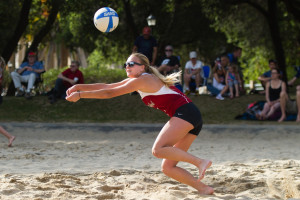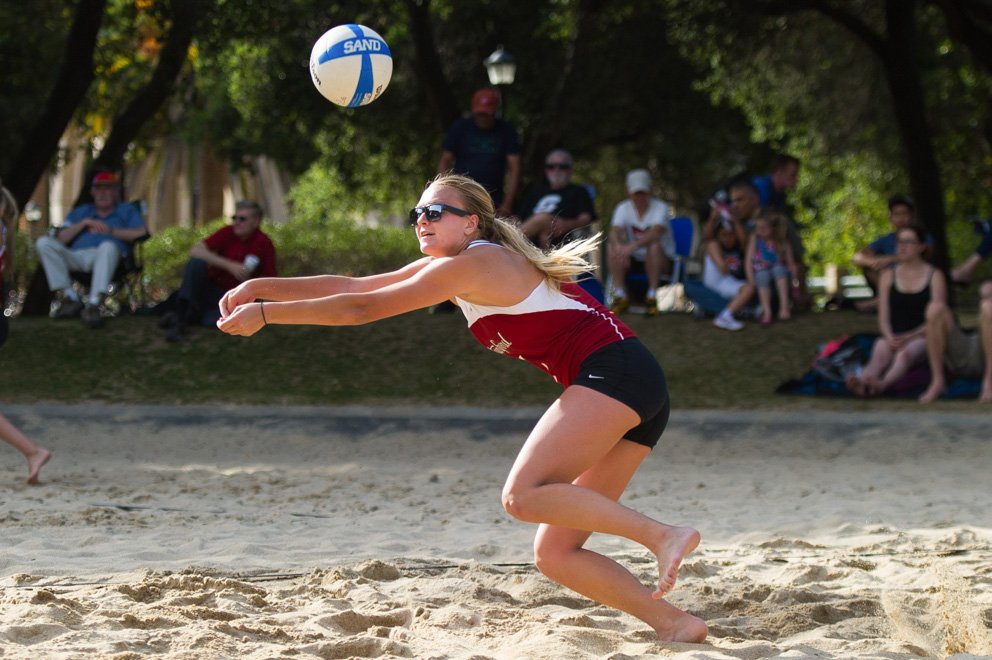With formidable wins thus far, the Stanford sand volleyball team is having its best season since its inception in 2013. In addition to finishing second out of eight teams at the NorCal Invitational in early March, the Cardinal recently swept San Jose State 5-0.
However, it hasn’t been easy for the team to become a serious competitor on the sand. While most other teams have completely separate indoor and sand programs, the Stanford volleyball team divides its time by preparing for both indoor and sand competitions.

Unlike many other colleges where the rosters are comprised almost completely of sand-only players, Stanford has five sand-only players. In its inaugural year, the team was completely comprised of indoor players and only signed on two non-indoor players last season. Additionally, last season, the sand team only had five practices before their first tournament in Hawaii.
“When we started two and a half years ago, our exposure to the game was very minor,” head sand and indoor volleyball coach John Dunning said.
Nevertheless, things are different this year. The team switched their training block back to the beginning of winter quarter.
“We trained eight weeks before our first tournament which made a huge difference,” said junior outside hitter Brittany Howard, who only began taking sand volleyball seriously when she arrived on the Farm in 2012.
“It’s been incredible to see how much we’ve all improved throughout the preseason until now,” senior outside hitter Lauren Birks said.
The new state-of-the-art sand facility donated by John Arrillaga has also helped step up the team’s game. Before, the team practiced on the sand courts by the Arrillaga Center for Sports and Recreation, and only four pairs could practice at a time. Now all eight pairs can practice at once, and the practices have become more efficient. The courts were also very visible to the public.
“We would sort of feel like we were on display,” Howard said. “Having the new courts has changed our mentality. This is a real deal.”
Although sand volleyball was originally instituted as a Stanford sport in part to allow indoor players to practice more in the off-season — the NCAA only allows athletes to practice eight hours a week out of season play — it is distinguishing itself as more of its own program, with plans to be comprised mostly of sand-only players in the near future.
The team is continuing to recruit sand-only players. In the 2015 indoor recruiting class, there are players who also know how to play sand.
“My guess is that it won’t be too long, where the team gets to be half indoor half outdoor,” Dunning said. “The best teams are sand-only teams.”
This is in part because the skillsets for sand and indoor volleyball, although seemingly similar, are actually very different. In indoor volleyball, each player has a very specialized skill set for her position. In sand, because there are only two players, they have to be good at everything. Sand volleyball has been instrumental in developing the team’s ball control, for example.
“I think it’s really helping everyone’s all-around game,” Howard said.
“In sand, it is also important to know the opponents and anticipate each play because it’s such a big court to cover. Bringing that skill to indoor is very valuable,” Dunning said.
While playing sand volleyball can bring a lot to the indoor court, indoor volleyball can also bring important skills to the sand.
“The indoor game is so fast that you have to have a high level of focus,” Dunning explained.
In indoor volleyball, the team would be able to watch film of their upcoming competitors and have an idea of what to expect, but that is not currently the case in sand. “It’s actually kind of an adventure because we don’t know very much,” Dunning said.
Because the sport is very new — it was just approved as the NCAA’s 90th championship in January of this year — it’s still hard to get the videos of the other teams before you play them. However, the further into the tournament they advance and the more exposure they get to the competing pairs, the more the Stanford pairs will learn about their competition.
As the team has improved, the players have started to take the practices and the program more seriously. Every time the team steps onto the sand courts, Dunning recognizes that each pair is excited to progress and see what they are going to get better at each day.
Although the two teams will probably become more divided in the future, Dunning still wants the indoor players to have the opportunity to practice with the sand team. It then depends on whether they are competitive enough to make one of the 10 competition spots.
The team’s next tournament is the Surf’n Turf Invitational, which begins April 3. The Cardinal are scheduled to play four teams over two days in Miami.
“Humidity, hard sun and wind aren’t something we experience much at Stanford, but we’ve been working as a team to prepare our game to adapt to the environment,” Birks said.
Stanford has started the season on a high note, but the team recognizes that No. 6 Florida International will be a tough competitor. The Panthers exploded onto the scene last week when they beat Pepperdine, which was previously ranked second in the American Volleyball Coaches Association Poll.
The Cardinal’s first game will be against Carson Newman on Friday at 5 a.m.
Contact Laura Stickells at lauraczs ‘at’ stanford.edu.
